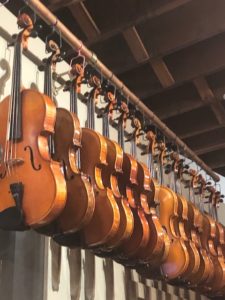 Several weeks ago, I attended a concert at Seman Violin, a wonderful, small venue that I discovered when a friend invited me there to see a favorite bluegrass band.
Several weeks ago, I attended a concert at Seman Violin, a wonderful, small venue that I discovered when a friend invited me there to see a favorite bluegrass band.
“Surprising” and “intimate” are the first words that come to mind.
A wide and shallow stage stands without much fanfare in front of around a hundred seats, making the listening and feeling experience extraordinary. You can actually observe the performers enjoying making music.
The modest-sized auditorium towards the back of the space was a major selling point when Peter Seman moved his workshop and retail operations to the location over a decade ago. He makes custom string instruments as well as selling, repairing and renting them.
Their concerts feature various genres of music that showcase strings, and the caliber of performer is top notch. It’s obvious that the featured musicians often have personal connections with Peter, who made many of their instruments, and they love to play here.
The atmosphere is delightfully informal. During intermission, it is not hard to talk to the artists directly.
On their mailing list since I came to hear The Henhouse Prowlers play with Pakistani musicians long before the pandemic, I recently took a friend to see a twenty-two year old cellist, David Caplan, perform with In-Ae Ha at the piano.
It was hard not to be moved. Compositions by Beethoven, Brahms and Rachmaninoff were featured. David Caplan, who I later learned had been coming to the store for most of his life, was more than technically proficient. He was very connected to the music.
I felt grateful to be able to catch his skill and commitment (from the front row, no less), but I was oddly moved by a short introduction to the program Peter Seman gave before David’s bow first touched a string.
Peter talked about having made David’s cello, which was modeled after a Stradivarius instrument made centuries ago.
In an age when most people are trying to get their “fifteen minutes of fame,” (more like fifteen seconds if you’re a TikTok or Twitter user), it astonishes me to witness anyone take pride in what he does without seeking the spotlight, when someone enjoys how what he does helps others look good.
In a conversation we had since the Caplan concert, I learned more about Peter, as a performer, businessman and craftsman.
He was exposed to several instruments as a kid growing up in Long Island and gravitated to the violin. Several of his friends picked up other string instruments. Despite being left-handed, he taught himself how to play until he excelled. He had a special fondness for bluegrass.
After two semesters, he dropped out of college and toured with a bluegrass band, playing professionally for ten years.
He always liked to explore small shops, looking for old violins. He recognized that he wanted to repair and restore old instruments and was advised that learning how to build them was the best strategy.
He moved to Chicago to attend the Chicago School of Violin Making, one of only a handful of schools in the world dedicated to the art, and grew his business in Skokie, Illinois, near Chicago.
He has made instruments for Andrew Bird (singer/songwriter), David Ragsdale (member of rock band, Kansas,) and Rachel Barton Pine (concert violinist), among other well-known musicians.
Sometimes, discriminating performers bought instruments he had already produced because they liked their sound and sometimes, Seman produced instruments to meet an artist’s specific requirements, achieving a particular sound or look or style. He has made five-string violins for some.
In our conversation, Seman explained that the violin was perfected three hundred years ago and that new ones still follow the same design. Experiments to make the instrument better have taken place, but the perfection of the classic design endures.
He confessed that making copies of older instruments is one of his greatest joys. He went on to describe the pleasure he gets from hearing an artist making music using an instrument he produced.
“People can think making violins is glamorous, but it’s really hard work. It’s hard on your hands. It’s hard on your body, the muscles, but I’m pretty motivated. I love getting new wood, seeing the wood, turning it into an instrument, and then seeing someone play something. It’s super satisfying. I don’t know how to describe it.”
Loving something so much that one of your greatest pleasures is giving it to someone else to make their own is no small thing.


Leave a comment